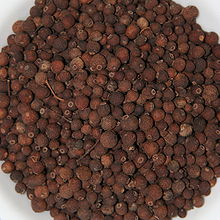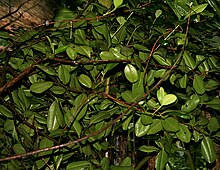Allspice
| Allspice | |
|---|---|

| |
| blooming twig, flower & fruit detail | |
| Scientific classification | |
| Kingdom: | |
| (unranked): | |
| (unranked): | |
| (unranked): | |
| Order: | |
| Family: | |
| Genus: | |
| Species: | P. dioica
|
| Binomial name | |
| Pimenta dioica | |
| Synonyms[1] | |
| |
Allspice, also called Jamaica pepper, pepper, myrtle pepper, pimenta,[2] Turkish Yenibahar, English pepper[3] or newspice, is the dried unripe fruit (berries, used as a spice) of Pimenta dioica, a midcanopy tree native to the Greater Antilles, southern Mexico, and Central America, now cultivated in many warm parts of the world.[4] The name 'allspice' was coined as early as 1621 by the English, who thought it combined the flavour of cinnamon, nutmeg, and cloves.[5]
Several unrelated fragrant shrubs are called "Carolina allspice" (Calycanthus floridus), "Japanese allspice" (Chimonanthus praecox), or "wild allspice" (Lindera benzoin). Allspice is also sometimes used to refer to the herb costmary (Tanacetum balsamita).
Preparation/form

Allspice is the dried fruit of the P. dioica plant. The fruits are picked when green and unripe and are traditionally dried in the sun. When dry, they are brown and resemble large brown smooth peppercorns. The whole fruits have a longer shelf life than the powdered product and produce a more aromatic product when freshly ground before use.
Fresh leaves are used where available. They are similar in texture to bay leaves and are thus infused during cooking and then removed before serving. Unlike bay leaves, they lose much flavor when dried and stored, so do not figure in commerce. The leaves and wood are often used for smoking meats where allspice is a local crop. Allspice can also be found in essential oil form.
Uses
Allspice is one of the most important ingredients of Caribbean cuisine. It is used in Caribbean jerk seasoning (the wood is used to smoke jerk in Jamaica, although the spice is a good substitute), in moles, and in pickling; it is also an ingredient in commercial sausage preparations and curry powders. Allspice is also indispensable in Middle Eastern cuisine, particularly in the Levant, where it is used to flavour a variety of stews and meat dishes. In Palestinian cuisine, for example, many main dishes call for allspice as the sole spice added for flavouring. In the U.S., it is used mostly in desserts, but it is also responsible for giving Cincinnati-style chili its distinctive aroma and flavour. Allspice is commonly used in Great Britain, and appears in many dishes, including cakes. Even in many countries where allspice is not very popular in the household, as in Germany, it is used in large amounts by commercial sausage makers. It is a main flavour used in barbecue sauces.[citation needed] In the West Indies, an allspice liqueur called "pimento[2] dram" is produced.
Allspice has also been used as a deodorant. Volatile oils found in the plant contain eugenol, a weak antimicrobial agent.[6]
Cultivation

The allspice tree, classified as an evergreen shrub, can reach 10–18 m (33–59 ft) in height. Allspice can be a small, scrubby tree, quite similar to the bay laurel in size and form. It can also be a tall, canopy tree, sometimes grown to provide shade for coffee trees planted underneath it. It can be grown outdoors in the tropics and subtropics with normal garden soil and watering. Smaller plants can be killed by frost, although larger plants are more tolerant. It adapts well to container culture and can be kept as a houseplant or in a greenhouse.
To protect the pimenta trade, the plant was guarded against export from Jamaica. Many attempts at growing the pimenta from seeds were reported, but all failed. At one time, the plant was thought to grow nowhere except in Jamaica, where the plant was readily spread by birds. Experiments were then performed using the constituents of bird droppings; however, these were also totally unsuccessful. Eventually, passage through the avian gut, whether due to the acidity or the elevated temperature, was found to be essential for germinating the seeds. Today, pimenta is spread by birds in Tonga and Hawaii, where it has become naturalized on Kauaʻi and Maui.[7]
Western history
Allspice (P. dioica) was encountered by Christopher Columbus on the island of Jamaica during his second voyage to the New World, and named by Dr. Diego Álvarez Chanca. It was introduced into European and Mediterranean cuisines in the 16th century. It continued to be grown primarily in Jamaica, though a few other Central American countries produced allspice in comparatively small quantities.[8]
References
- ^ "The Plant List: A Working List of All Plant Species". Retrieved 19 August 2015.
- ^ a b The name pimento, often substituted when pimenta is intended, is also used for a certain kind of large, red, heart-shaped sweet pepper.
- ^ In Hebrew, the spice is called פלפל אנגלי, literally: English pepper.
- ^ Riffle, Robert L. (1 August 1998). The Tropical Look: An Encyclopedia of Dramatic Landscape Plants. Timber Press. ISBN 0-88192-422-9.
- ^ Oxford English Dictionary (2 ed.). Oxford, UK: Clarendon Press. 1 March 1989. ISBN 0-19-861186-2. Retrieved 12 December 2009.
- ^ Yaniv, Zohara; Bacharach, Uriel, eds. (1 April 2005). Handbook of Medicinal Plants. Brighamton, New York: Food Products Press and Haworth Medical Press. p. 336. ISBN 1-56022-994-2.
- ^ Lorence, David H.; Flynn, Timothy W.; Wagner, Warren L. (1 March 1995). "Contributions to the Flora of Hawai'i III" (PDF). Bishop Museum Occasional Papers. 41. Honolulu, Hawaii: Bishop Museum Press: 19–58. ISSN 0893-1348. Retrieved 12 December 2009.
- ^ Nancy Gaifyllia. "About.com Greek Food – Allspice". Archived from the original on 7 July 2011. Retrieved 26 June 2011.
{{cite web}}: Unknown parameter|deadurl=ignored (|url-status=suggested) (help)
External links
 Media related to Pimenta dioica at Wikimedia Commons
Media related to Pimenta dioica at Wikimedia Commons Media related to Allspice at Wikimedia Commons
Media related to Allspice at Wikimedia Commons Data related to Pimenta dioica at Wikispecies
Data related to Pimenta dioica at Wikispecies- "Pimenta dioica". Floridata Plant Encyclopedia.
- "Pimenta dioica". Plants of Hawaii. Hawaiian Ecosystems at Risk project (HEAR).
- "Allspice". Gernot Katzer's Spice Pages.
- "Allspice". Trade Winds Fruit.
- "Allspice". The Encyclopedia of Spices. Epicentre.com.
